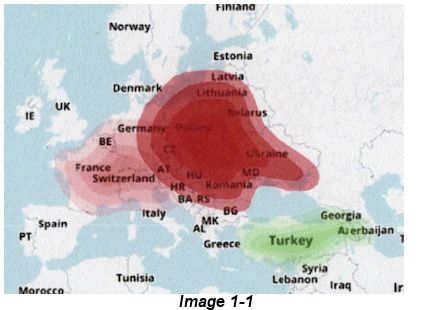DNA Project
I’ve always had a desire to know where our ancestors came from. There has always been a tug at my heart to go to Yugoslavia, now Croatia, to find out about my relatives and ancestors. Due to my military duties and security clearance, I was never able to travel to a communist controlled country. Time passed and before you knew it, my parents had departed and I could not ask specific details as to where our ancestors came from. I know that I have a strong bond to the Croatian people. I cannot describe it, but the tug for self-determination and realization has always been burning inside of me. Being in the Army and Air Force for 20 years cost me a lot; family get-togethers, weddings, anniversaries, holidays, family bonding, etc. It has left a void in me that cannot be filled. I have to repeat this; I have a strong desire to know what my genetic makeup consists of.
I finally took the plunge and got myself a DNA test with Family Tree DNA. I was not happy with the initial results of the 67 marker testing, so I eventually got the 111 marker test and was pleasantly surprised. The first thing I noticed is that my DNA showed I was 82% European and 18% Middle Eastern. Look at Image 1-1 as it will show the regions of where the Jerkovic ancestors may have established their domicile. It does not show Saudi Arabia or Iraq as the map does not cover the period of the Ice Age. During that  period in Europe 25,000 years ago, our ancestors, if they were settled in Europe, probably journeyed south to the area of Saudi Arabia, which was then known as Arabia, to get away from the cold freezing weather and creeping ice. When they felt it was safe to go back north, they migrated and possibly settled in present day Iraq and Syria for a period of time. Another scenario could be that the Jerkovic ancestors originated in northern Saudi Arabia as my DNA test shows, thereby making the above comments moot. Their migratory travels would have taken them through the Byzantine Empire (modern day Turkey, Greece, and Bulgaria) and into what is today Croatia. I found this next phase to be quite interesting. After settling into the regions of Bosnia and Herzegovina, and Croatia, some ancestors decided to cross the Adriatic Sea and journey into Italy. Others continued through what is today Switzerland and/or France and through Belgium, the Netherlands, Denmark, and finally Sweden. I was flabbergasted by this information.
period in Europe 25,000 years ago, our ancestors, if they were settled in Europe, probably journeyed south to the area of Saudi Arabia, which was then known as Arabia, to get away from the cold freezing weather and creeping ice. When they felt it was safe to go back north, they migrated and possibly settled in present day Iraq and Syria for a period of time. Another scenario could be that the Jerkovic ancestors originated in northern Saudi Arabia as my DNA test shows, thereby making the above comments moot. Their migratory travels would have taken them through the Byzantine Empire (modern day Turkey, Greece, and Bulgaria) and into what is today Croatia. I found this next phase to be quite interesting. After settling into the regions of Bosnia and Herzegovina, and Croatia, some ancestors decided to cross the Adriatic Sea and journey into Italy. Others continued through what is today Switzerland and/or France and through Belgium, the Netherlands, Denmark, and finally Sweden. I was flabbergasted by this information.
I was further astonished to find out that I had DNA matches in Bosnia and Herzegovina, Germany, Greece, Hungary, Italy, Poland, Romania, Russian Federation, Slovakia, and the Ukraine. I was pleasantly surprised; no shocked, to receive emails from Russia, Sweden, and Italy, inquiring into our DNA matches and that we have a distant cousin link. I have submitted an email to a cousin in Romania, but have not received an answer from the gentleman yet. The male in Russia is a 5th cousin removed; the lady in Sweden and I are trying to determine the connection with our ancestors; but the cousin in Italy is a verifiable entity, 3rd - 5th cousin. I have another 102 individuals to check, anywhere up to 5th cousin removed, so I have my work cut out for me. This has all happened because of taking a DNA test. Is a DNA test worth it? I feel it is even though it can become costly. It is up to each individual, if they so chose, as to how far they wish to pursue their results.
I must regress for a moment about the migration of our Jerkovic ancestors. In communications with other Jerkovices in present day Croatia, most agree that the Jerkovic clan developed around Medjugorje in Bosnia-Herzegovina. Around the 16th and 17th centuries, they started branching out across Croatia where today the Jerkovic surname is a very common name. It was rated at number 67 as the most popular Croatian family name. Today, there are more than 2,000 people called Jerkovic. Zagreb is the most popular residence with 12%; Split and Slavonski Brod follow closely with 10%; Metkovic at 5%; and Rijeka with 4%. Two thousand people does not seem like a lot, but we are talking about a small country of 4, 284,889 people according to the 2011 census.

